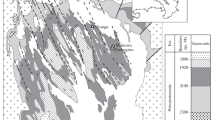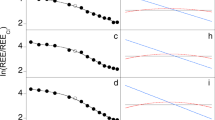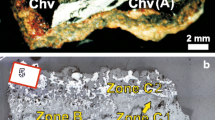Abstract
Sequential alteration of volcanic rock of rhyolitic composition to a precursor of endellite, and thence to tubular endellite, may be observed at a hot spring about 27 km north of Ciudad Hidalgo, Michoacan, Mexico. Ojo Caliente de Laguna Larga (or Verde) yields H2S-SO2-containing water, temperature about 45°C pH 3·5–3·7, from multiple orifices in vesicular and slabby rock with which the water reacts.
First-stage alteration of the rock consisted of permeation and dissolution, accompanied by deposition of clay substance in vesicle walls. The clay substance, although “amorphous” to X-rays, yields a weak DTA of endellite, and kaolinite. It is interpreted as a precursor of endellite. Further reaction included continued filling of vesicles and spreading argillation which coalesced between vesicles and other rock pores. Ultimately, the rock was completely “digested” to well-defined endellites.
Strong desilication and depotassication of the rock is indicated by the dissolved substances in the spring water: Si 59·1 (equivalent to 127 SiO2) ug/ml: Al, 1·63; Fe, 0·65: Mg, 0·21: Ca, 178: Na, 0·73: K, 13·7. Despite high K+, predominantly high H+ and Al3+ induce formation of endellite. The clay-water system accords well with stability diagrams.
Allophane-endellite in Indiana and endellite at Stanford, Kentucky, are formed from cold, strongly acid, meteoric-water solutions high in Si and Al relative to kaolinite dissolved in water. Factors of genesis common to both hot- and cold-water endellite are cited, suggesting that they are premissively critical, but not necessarily restrictive, to the origin of endellite.
Résumé
L’altération séquentielle d’une roche volcanique de composition rhyolitique en un précurseur de l’endellite puis en une endellite tubulaire, peut-être observée dans une source thermale, à environ 27 km au nord de Ciudad Hidalgo, Michoacan, Mexique. Ojo Caliente de Laguna Larga (ou Verde) fournit une eau contenant H2S et SO2,àune température d’environ 45°C etàpH 3,5–3,7; cette eau s’échappe des multiples orifices d’une roche vésiculaire et stratifiée; elle réagit avec la roche.
La première étape de l’altération de la roche consiste en une pénétration et une dissolution, accompagnées du dépôt d’une substance argileuse sur les parois des vésicules. La substance argileuse, quoique “amorphe” aux rayons X, donne, en ATD, une courbe peu marquée d’endellite et de la kaolinite. Ceci est interprété comme un précurseur de l’endellite. Une réaction plus poussée entraîne le remplissage complet des vésicules et l’extension de l’argilification, qui soude les vésicules aux autres pores de la roche. A la fin, la roche est totalement “digérée” en endellite bien définie.
L’appauvrissement intensif de la roche en silice et en potassium ressort de l’analyse des substances que l’on trouve dissoutes dans l’eau de la source: Si 59,1 (équivalent à 127 SiO2) µg/ml: Al 1,63; Fe, 0,65: Mg, 0,21: Ca, 178: Na, 0,73: K, 13,7. En dépit de la forte teneur en K+, les teneurs élevées en H+ et Al3+ induisent d’une façon prédominante la formation de l’endellite. Le système argile—eau concorde bien avec les diagrammes de stabilité.
Le mélange allophane-endellite dans l’Indiana et l’endellite de Stanford, Kentucky, sont formés à partir de solutions d’eau atmosphérique froides et fortement acides, qui ont une forte teneur en Si et Al par rapport à la kaolinite dissoute dans l’eau. Les facteurs de la genèse communs aux endellites d’eau chaude et d’eau froide sont décrits, en suggérant qu’ils sont peut-être critiques, mais pas nécessairement restrictifs, pour l’origine de l’endellite.
Kurzreferat
Die aufeinanderfolgende Veränderung von vulkanischem Gestein Rhyolith-artiger Zusammensetzung zu einem Vorläufer des Endellith, und aus diesem zu rohrförmigem Endellith, kann an einer heissen Quelle etwa 27 km nördlich der Cidudad Hidalgo, Michoacan, Mexiko beobachtet werden. Ojo Caliente de Laguna Larga (oder Verde) liefert H2S-SO2-haltiges Wasser, Temperatur ungefähr 45°C, pH 3,5–3,7 aus einer Anzahl von Öffnungen in blasigem und schiefrigem Gestein mit welchem das Wasser reagiert.
Die erste Veränderungsstufe des Gesteins bestand aus Durchdringung und Auflösung, verbunden mit Ablagerung tonigen Materials in den Bläschenwänden. Das tonige Material Erscheint wohl “amorph” under Röntgenbestrahlung, zeigt aber ein schwaches DTA von Endellith und Kaolinit. Es wird als ein Vorläufer des Endelliths angesehen. Die weitere Reaktion umfasste weitere Füllung der Bläschen und Ausbreitung der Tonbildung mit Kaoleszenz zwischen Bläschen und Gesteinsporen. Schliesslich war komplette “Digestion” zu wohlausgebildetem Endellith erfolgt.
Eine Analyse der in dem Quellwasser aufgelösten Substanzen deutet auf starke Entkieselung und Kaliumverlust des Gesteines hin: Si 59,1 (äquivalent 127 SiO2) µ/ml; Al 1,63; Fe 0,65; Mg 0,21; Ca 178; Na 0,73; K 13,7. Trotz hohem K+ Gehalt, wird die Bildung von Endellith in erster Linie durch hohe H+ und Al3+ Werte gefördert. Das Ton-Wasser System stimmt gut mit dem Stabilitätsdiagramm überein.
Allophan-Endellith in Indiana und Endellith in Stanford Kentucky werden aus kalten, stark sauren, meteorisch-wässrigen Lösungen, mit hohen Si und Al Gehalten im Verhältnis zu dem im Wasser gelösten Kaolinit, gebildet. Es werden Faktoren erwähnt, die der Entstehung von Endellith aus heissem sowie aus kaltem Wasser gemeinsam sind, und die als kritish für die Ermöglichung einer Endellithbildung, jedoch nicht unbedingt als beschränkend angesehen werden.
Резюме
Последовательное изменение вулканической породы риолитового состава до предшествующей энделлиту фазы и затем в трубчатый энделлит наблюдается вблизи горячего источника, расположенного около 27 км севернее Сьюдад Идальго (Мичоакан, Мексика). Источник Охо Кальенте де Лагуна Ларга (или Верде) дает содержащие H2S-SO2 воды с температурой около 45°С и pH 3,5–3,7, поступающие из сложного жерла в пористой и плитчатой породе, подвергающейся изменению.
Первая стадия изменения породы состоит в проникновении воды и растворении, сопровождающимся отложением глинистого вещества в пузырчатых стенках. Глинистое вещество хотя и является рентгено-аморфным, но дает слабую ДТА-картину энделлита и каолинита. Эта фаза интерпретирована как предшествующая энделлиту. Дальнейшее взаимодействие породы с водой включает постепенное заполнение мелких полостей и аргиллизацию породы между мелкими полостями и порами. В конце концов порода полностью «переваривается» в типичный энделлит.
Сильная десиликация и декализация породы устанавливается по составу воды источника (мг/мл): Si — 59,1 (эквивалентно 127 Si02); Аl — 1,63; Fe — 0,65; Mg — 0,21; Са — 0,178; Na — 0,73; K — 13,7. Несмотря на высокое содержание К+, преобладающе высокое содержание Н+ и Аl3+ приводит к образованию энделлита. Система глина — вода согласуется с диаграммами устойчивости. Аллофан-энделлит Индианы и энделлит Стэнфорда (Кентуки) образовались из холодных сильно кислых атмосферных вод с высоким содержанием Si и Аl по отношению к каолиниту, растворенному в воде. Рассмотрены факторы образования энделлита из горячих и холодных вод, которые признаются возможными, но не единственными.
Similar content being viewed by others
References
Callaghan, E. (1948) Endellite deposits in Gardiner Ridge Mine, Lawrence County, Indiana: Indiana Dep. Cons. Div. Geot. Bull. 1.
Feth, J. H., Roberson, C. E. and Polzer, W. L. (1968) Sources of mineral constituents in water from granitic rocks, Sierra Nevada, California and Nevada: U.S. Geol. Survey Water Supply Paper 1535-I, 70 pp.
Keller, W. D., McGrain, Preston, Reesman, A. L. and Saum, N. M. (1966) Observations on the origin of endellite in Kentucky, and their extension in “indianaite”: Clays and Clay Minerals 13, 107–120.
Keller, W. D. and Hanson, R. F. (1969) Hydrothermal argillation of volcanic pipes in limestone in Mexico: Clays and Clay Minerals 17, 9–12.
Raymahashay, B. C. (1968) A geochemical study of rock alteration by hot springs in the paint Pot Hill area, Yellowstone Park: Geochem. et Cosmochim. Acta 32, 499–522.
Reesman, A. L., Pickett, E. E. and Keller, W. D. (1969) Aluminum ions in aqueous solutions: Am. J. Sci. 267, 99–113.
Sunderman, J. A. (1963) Mineral deposits at the Mississippian-Pennsylvanian unconformity in southwestern Indiana, Ph.D. Thesis, Indiana University.
Author information
Authors and Affiliations
Rights and permissions
About this article
Cite this article
Keller, W.D., Hanson, R.F., Huang, W.H. et al. Sequential Active Alteration of Rhyolitic Volcanic Rock to Endellite and a Precursor Phase of it at a Spring in Michoacan, Mexico. Clays Clay Miner. 19, 121–127 (1971). https://doi.org/10.1346/CCMN.1971.0190209
Received:
Published:
Issue Date:
DOI: https://doi.org/10.1346/CCMN.1971.0190209




